CFD-FVM-01: Navier-Stokes Equations

整理自
Versteeg H K, Malalasekera W. An introduction to computational fluid dynamics: the finite volume method[M]. Pearson education, 2007.
Introduction
CFD codes are structured around the numerical algorithms that can tackle fluid flow problems.
All codes contain three main elements:
- a pre-processor
- a solver
- a post-processor.
Solver

The most popular solution procedures are by the TDMA (tri-diagonal matrix algorithm) line-by-line solver of the algebraic equations and the SIMPLE algorithm to ensure correct linkage between pressure and velocity. Commercial codes may also give the user a selection of further, more recent, techniques such as Gauss–Seidel point iterative techniques with multigrid accelerators and conjugate gradient methods.
Conservation laws of fluid motion and boundary conditions
The governing equations of fluid flow represent mathematical statements of the conservation laws of physics:
- The mass of a fluid is conserved
- The rate of change of momentum equals the sum of the forces on a fluid particle (Newton’s second law)
- The rate of change of energy is equal to the sum of the rate of heat addition to and the rate of work done on a fluid particle (first law of thermodynamics)
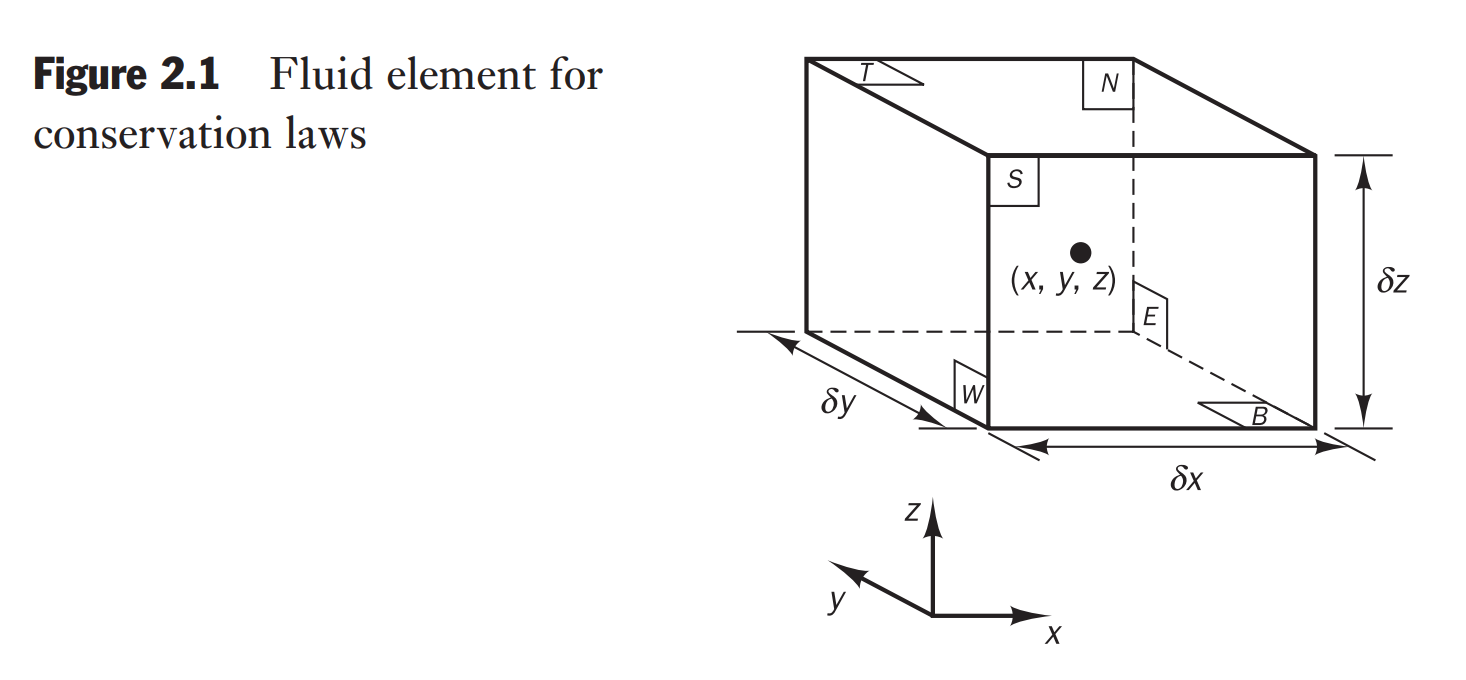
The element under consideration is so small that fluid properties at the faces can be expressed accurately enough by means of the first two terms of a Taylor series expansion. So, for example, the pressure at the
Mass conservation in three dimensions
Rate of increase of mass in fluid element = Net rate of flow of mass into fluid element
The Rate of increase of mass in the fluid element is
According to the figure
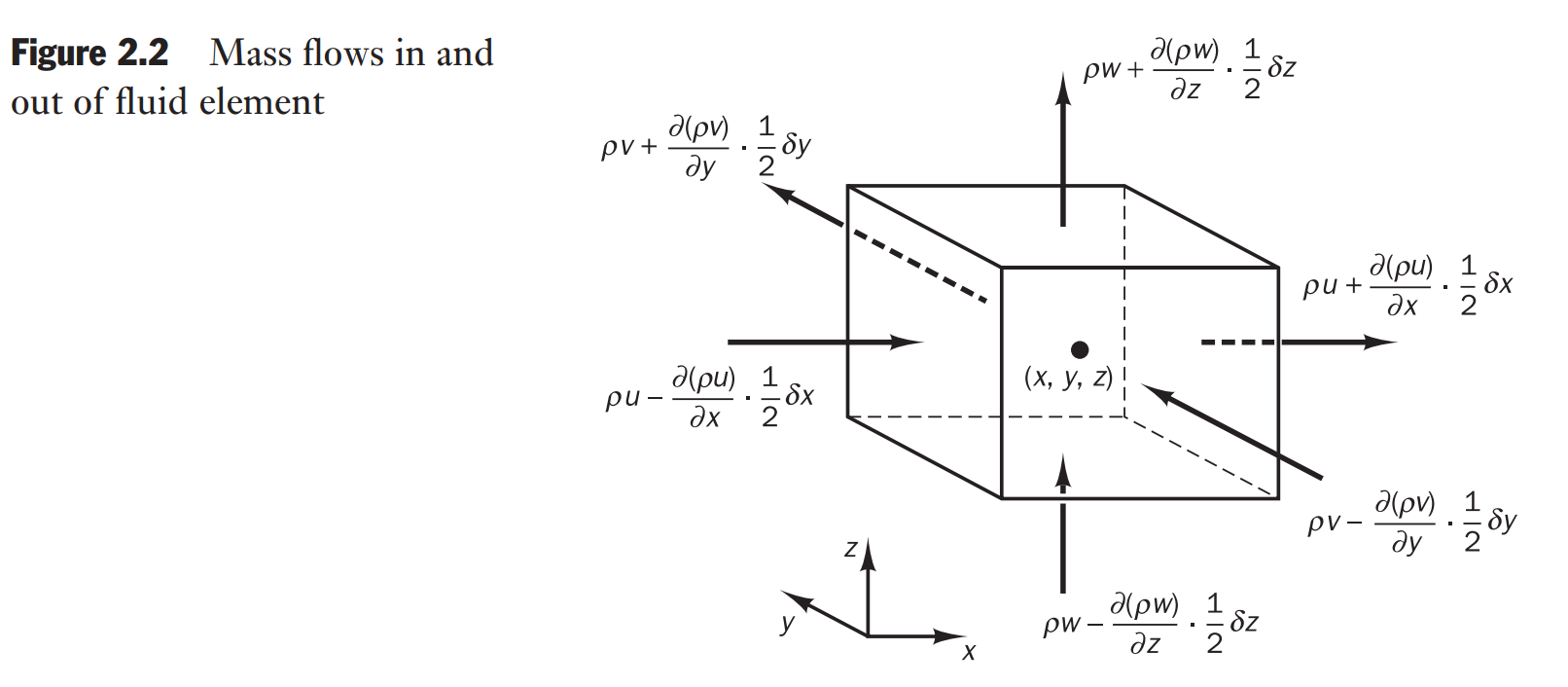
the Net rate of flow of mass into fluid element is
Divided by the element volume
or in more compact vector notation
For an incompressible fluid (i.e. a liquid) the density
Rates of change following a fluid particle and for a fluid element
Let the value of a property per unit mass be denoted by
which is
Rate of increase of
of fluid element + Net rate of flow of of fluid element = Rate of increase of for a fluid particle
To construct the three components of the momentum equation and the energy equation the relevant entries for φ and their rates of change per unit volume are given below:
| x-momentum | |||
| y-momentum | |||
| z-momentum | |||
| energy |
Momentum equation in three dimensions
Newton’s second law states that the rate of change of momentum of a fluid particle equals the sum of the forces on the particle:
Rate of increase of momentum of fluid particle = Sum of forces on fluid particle
- surface forces
- pressure forces
- viscous forces
- gravity force (?)
- body forces
- centrifugal force
- Coriolis force
- electromagnetic force
It is common practice to highlight the contributions due to the surface forces as separate terms in the momentum equation and to include the effects of body forces as source terms.
The suffices
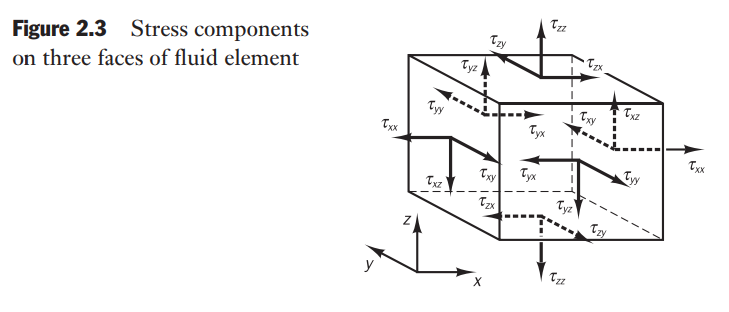
On the pair of faces
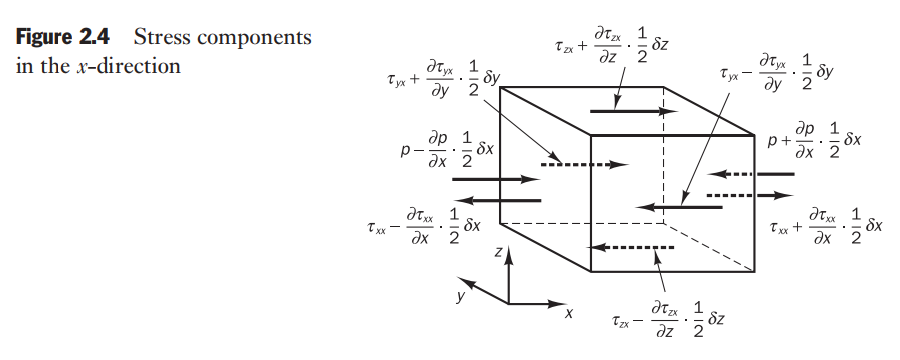
Of this sense, the net force in the
Finally the net force in the x-direction on faces
The total force per unit volume on the fluid due to these surface stresses is equal to (divided by the volume
Without considering the body forces in further detail their overall effect can be included by defining a source
Hence,
usual sign convention takes a tensile stress to be the positive normal stress so that the pressure, which is by definition a compressive normal stress, has a minus sign.
Energy equation in three dimensions
Rate of increase of energy of fluid particle = Net rate of heat added to fluid particle + Net rate of work done on fluid particle
Work done by surface forces
The rate of work done on the fluid particle in the element by a surface force is equal to the product of the force and velocity component in the direction of the force. For
For
These yield the following total rate of work done on the fluid particle by
surface stresses:
Energy flux due to heat conduction
The heat flux vector
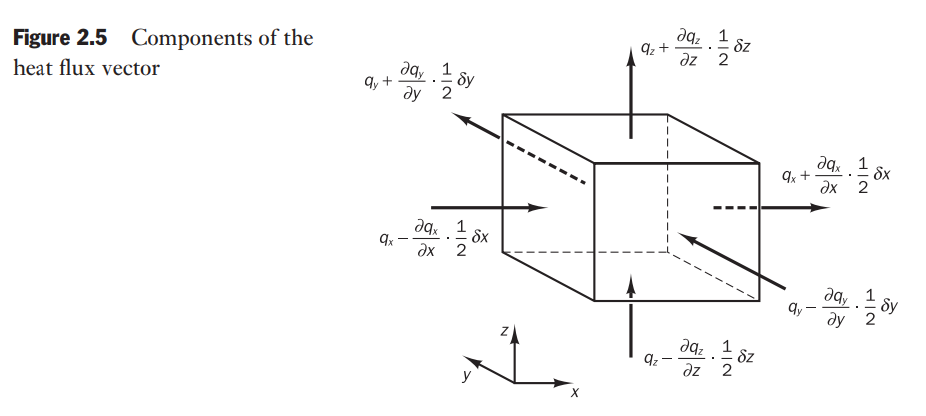
For face
For
The total rate of heat added to the fluid particle per unit volume due to heat flow across its boundaries (divided by the volume):
Fourier’s law of heat conduction relates the heat flux to the local temperature gradient. So
or
The final form of the rate of heat addition to the fluid particle due to heat conduction across element boundaries:
Energy equation
where
Multiplying the momentum equations by corresponding velocity components we have the kinetic energy equation:
Subtracting the kinetic energy equation from the energy equation and defining a new source term as
For the special case of an incompressible fluid we have
For compressible flows the above equation is often rearranged to give an equation for the enthalpy. The specific enthalpy
and
Substitution of the above equation into the energy equation and some rearrangement yields the (total) enthalpy equation
Equation of state
We can describe the state of a substance in thermodynamic equilibrium by means of just two state variables. Equations of state relate the other variables to the two state variables. If we use
For a perfect gas,
In the flow of compressible fluids the equations of state provide the linkage between the energy equation on the one hand and mass conservation and momentum equations on the other. This linkage arises through the possibility of density variations as a result of pressure and temperature variations in the flow field.
Liquids and gases flowing at low speeds behave as incompressible fluids. Without density variations there is no linkage between the energy equation and the mass conservation and momentum equations. The flow field can often be solved by considering mass conservation and momentum equations only. The energy equation only needs to be solved alongside the others if the problem involves heat transfer.
Navier-Stokes equations for a Newtonian fluid
In many fluid flows the viscous stresses can be expressed as functions of the local deformation rate or strain rate.
There are three linear elongating deformation components:
There are also six shearing linear deformation components:
The volumetric deformation is given by
Newtonian fluid the viscous stresses are proportional to the rates of deformation
The three-dimensional form of Newton’s law of viscosity for compressible flows involves two constants of proportionality: the first (dynamic) viscosity,
Not much is known about the second viscosity λ, because its effect is small in practice. For gases a good working approximation can be obtained by taking the value
Now we have the so-called Navier–Stokes equations:
Often it is useful to rearrange the viscous stress terms as follows:
The viscous stresses in the
If we use the Newtonian model for viscous stresses in the internal energy
equation we obtain after some rearrangement
All the effects due to viscous stresses in this internal energy equation are described by the dissipation function
The dissipation function is non-negative since it only contains squared terms and represents a source of internal energy due to deformation work on the fluid particle. This work is extracted from the mechanical agency which causes the motion and converted into internal energy or heat.
Conservative form of the governing equations of fluid flow
| Continuity | |
| x-momentum | |
| y-momentum | |
| z-momentum | |
| Energy | |
| Equations of state |
Differential and integral forms of the general transport equations
If we introduce a general variable

In order to bring out the common features we have, of course, had to hide the terms that are not shared between the equations in the source terms.
The key step of the finite volume method is the integration over a three-dimensional control volume (CV):
Gauss’s divergence theorem: For a vector
Hence, the above equation can be written as follows:

In steady state problems:
In time-dependent problems: